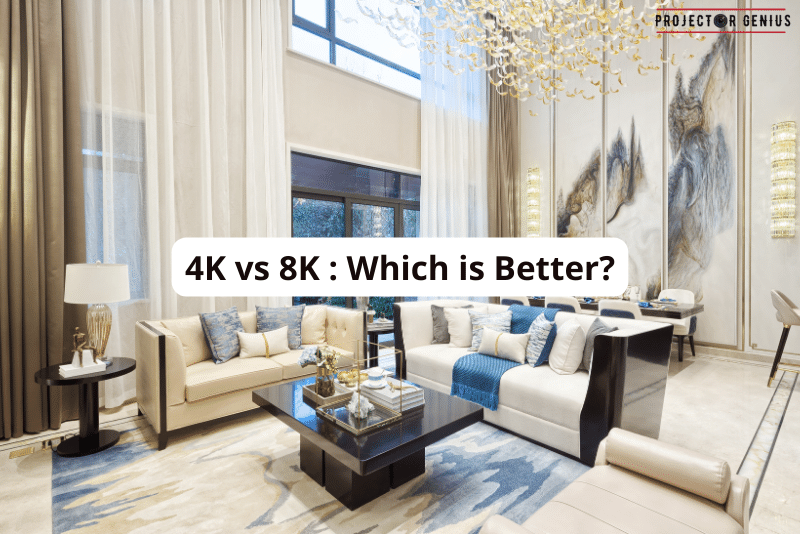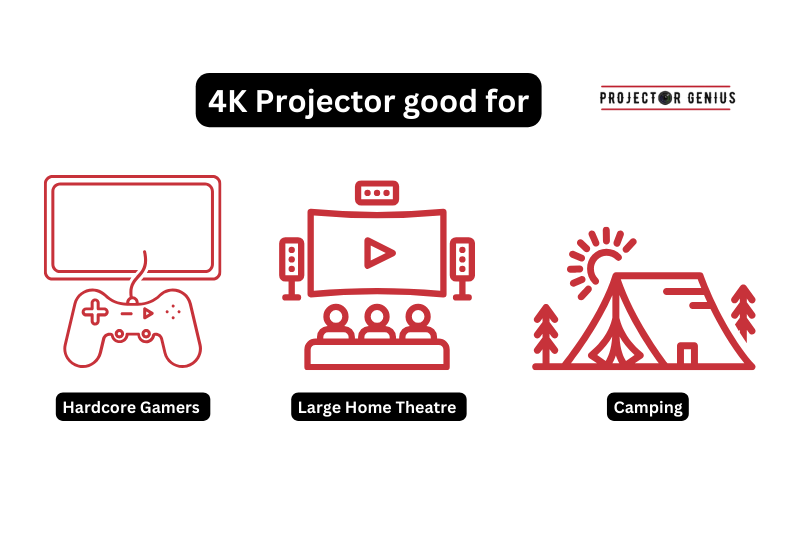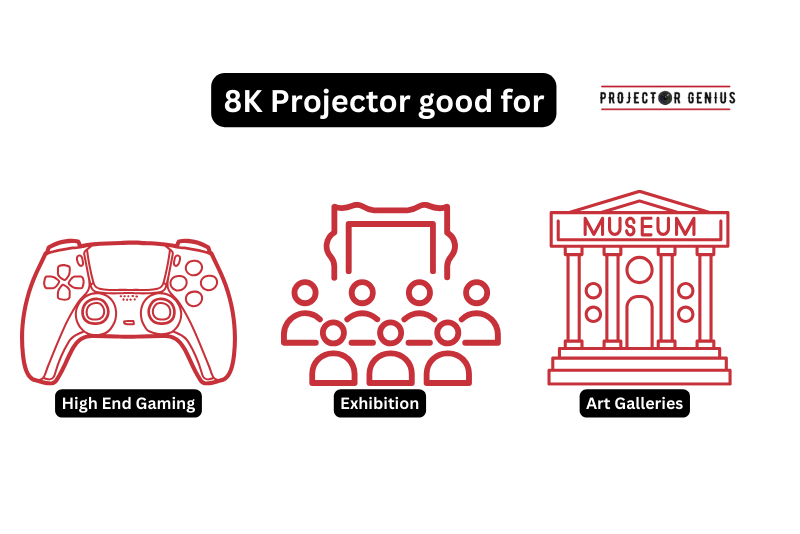4K vs 8K: Which is Better?
-
 Written by:
Kristy Roger
Written by:
Kristy Roger
- Last Updated:
So, you’re wondering which is the best 4K vs 8K.
Throughout this article, I’ll talk you through the detailed knowledge of 4K vs 8K. I’ll also help you decide which Resolution works best for you.
4K vs 8K? The choice between 4K and 8K depends on your specific needs. If you have a larger screen or want the highest resolution for professional purposes, 8K offers superior clarity. However, for most consumers, 4K provides an excellent viewing experience and is more affordable.

I recommend using the Table of Contents to quickly access the information you need.
My article is designed to cater to home cinema users of all levels, from Beginners to Advanced enthusiasts.
Table of Contents
What is 4K?
4K, also known as Ultra High Definition (UHD), is a video display resolution format characterized by its exceptionally high pixel count. The term “4K” refers to the horizontal pixel count, which is approximately 4,000 pixels.
In the standard 4K resolution, the display has approximately 3840 pixels in width and 2160 pixels in height. This results in a total of over 8 million pixels, providing an incredibly detailed and sharp image.
4K has become a standard in modern high-end television sets, digital cinema, and professional video production. It offers a significant improvement in image quality over previous resolutions like 1080p (Full HD), providing more detail, clarity, and a more immersive viewing experience.
It’s worth noting that there are variations of 4K, including “True 4K” which has a resolution of 4096×2160 pixels and is commonly used in digital cinema. Additionally, there is 8K, which is even higher in resolution with approximately 8,000 horizontal pixels, providing an even more detailed image.
What is 8K?
8K is an ultra-high-definition video display resolution format known for its incredibly high pixel count. The term “8K” refers to the horizontal pixel count, which is approximately 8,000 pixels.
In the standard 8K resolution, the display has approximately 7680 pixels in width and 4320 pixels in height. This results in a total of over 33 million pixels, providing an extraordinarily detailed and sharp image.
8K represents a significant leap forward in display technology and is considered the next frontier in high-resolution video. It offers an even greater level of detail and clarity compared to 4K, making it particularly well-suited for very large screens or for applications that require extremely high-quality visuals, such as digital cinema, high-end professional video production, and advanced medical imaging.
Difference between 4K and 8K Projector
Diving into the world of high-definition visuals, I’ve often wondered about the real differences between 4K and 8K. Here’s what I’ve discovered:
Resolution Matters
When I first looked at the numbers, they spoke volumes. 4K offers a resolution of 3840 x 2160 pixels. That’s impressive! But then, 8K steps in with a resolution of 7680 x 4320 pixels. That’s four times the detail of 4K!
Seeing the Difference
With 8K’s higher pixel density, images look smoother and more lifelike, especially on big screens. But on screens smaller than 75 inches, 4K still shines bright and clear.
Content Choices
While I’ve enjoyed a lot of 4K shows on platforms like Netflix and YouTube, finding true 8K content feels like a treasure hunt. It’s out there, but not as common.
What’s in the Store?
Walking through electronics stores, 4K TVs and monitors catch my eye everywhere. They fit all budgets. But 8K? They’re like the luxury cars of screens – rarer and pricier.
Thinking of the Wallet
If budget is on my mind, 4K is a friendlier choice. It offers great quality without the hefty price tag of 8K.
In the end, both 4K and 8K dazzle in their own ways. It’s all about what you’re looking for and how much you’re willing to spend. For now, I’m enjoying the crispness of 4K, but who knows? Maybe an 8K screen is in my future!
Factors to Consider When Choosing Between 4K and 8K Projectors
When deciding between a 4K and 8K projector, there are several important factors to consider. Picture quality is a top priority for me, so I carefully assess the resolution. 8K projectors offer incredibly sharp and detailed images, but they come at a higher cost.
Next, I think about the size of my viewing area. A larger screen benefits from higher resolution, so if I have a spacious room, an 8K projector might be worth the investment. However, for a smaller space, a 4K projector can still deliver impressive visuals without breaking the bank.
Brightness is another crucial aspect. I need to ensure that the projector provides enough lumens to maintain clear images, especially if I plan to watch in a well-lit room. 4K projectors often excel in this area, offering a bright and vibrant display.
Considering my budget is also vital. 8K projectors tend to be more expensive than their 4K counterparts. I weigh the benefits of the higher resolution against the cost to determine if it aligns with my financial plan.
Content availability is something I take into account as well. While 4K content is widespread, 8K content is still limited. If I mainly watch 4K videos, a 4K projector might be the more practical choice.
Connectivity options matter too. I assess the types and number of ports available on the projector to ensure compatibility with my devices. This ensures a seamless and hassle-free setup.
Lastly, I think about future-proofing. Technology evolves rapidly, and considering the longevity of my investment is wise. While 8K projectors offer cutting-edge resolution, 4K projectors are still highly capable and might suffice for years to come.
In conclusion, choosing between a 4K and 8K projector requires careful consideration of resolution, viewing area, brightness, budget, content availability, connectivity, and future-proofing. By weighing these factors, I can make an informed decision that aligns with my preferences and needs.
FAQ (Frequently Asked Question)
Is 8K Resolution Significantly Better than 4K for all Content?
Yes, 8K resolution isn’t necessarily significantly better than 4K for all content. Some factors come into play. For instance, the screen size and viewing distance matter a lot. With a smaller screen or sitting farther away, the difference might not be striking.
Also, content availability is a crucial factor. Right now, 4K content is more widespread and accessible. 8K content is still quite limited, so the advantage may not be noticeable for most things I watch.
Moreover, the type of content makes a difference. For highly detailed videos, like nature documentaries or high-budget films, 8K shines. But for everyday TV shows or YouTube videos, 4K is often more than enough. Finally, consider the cost. 8K technology is still quite expensive compared to 4K. So, it’s not always a significant leap in quality for every type of content.
Do all Devices Support 8K Resolution?
No, not all devices support 8K resolution. It’s crucial to check if a device has the necessary hardware and capabilities before attempting to view content in 8K. Many older or lower-end devices may not be equipped to handle 8K, as it demands a significant amount of processing power and memory. Therefore, it’s important to verify the specifications of a device to ensure it can display content in 8K without compromising performance or quality.
While 8K resolution offers remarkable detail and clarity, it’s important to note that its benefits may not be universally noticeable across all types of content. For instance, on smaller screens or from a distance, the difference between 4K and 8K may be less discernible.
Additionally, the availability of 8K content is still limited compared to 4K, which is more widely accessible. Therefore, whether 8K is significantly better than 4K depends on factors such as screen size, viewing distance, and the type of content being viewed.
Is 4K still Relevant with the Advent of 8K Displays?
Yes, 4K remains relevant even with the introduction of 8K displays. While 8K offers a remarkable level of detail, 4K continues to be a widely used and practical resolution for many applications. In fact, most content available today, including movies, TV shows, and streaming platforms, is optimized for 4K. This means that for the majority of viewers, 4K provides an excellent level of visual quality. Moreover, 4K displays are more affordable and accessible to a broader range of consumers, making them a popular choice for home entertainment systems and gaming setups.
Furthermore, factors like viewing distance and screen size play a crucial role in determining the perceived benefits of higher resolutions. For smaller screens or situations where viewers are positioned at a standard distance, the difference between 4K and 8K may not be as pronounced.
Additionally, 8K content is still relatively limited, and not all production equipment is capable of capturing or rendering content in 8K. This means that for the foreseeable future, 4K will remain a relevant and widely used resolution in the world of visual entertainment.
How does Streaming Quality Differ Between 4K and 8K?
Yes, there is a noticeable difference in streaming quality between 4K and 8K. When streaming content in 4K, the level of detail and clarity is already quite impressive.
However, with 8K streaming, the visual experience takes a significant leap forward. The additional pixels in an 8K stream bring out finer details, making the image incredibly sharp and lifelike. It’s like seeing a scene with an astonishing level of clarity, almost as if you’re right there in person. This is especially noticeable on larger screens, where the higher resolution of 8K truly shines. However, it’s important to note that streaming 8K content requires a robust and fast internet connection due to the considerable amount of data involved.
On the other hand, 4K streaming remains an excellent choice for most viewers. It provides a high-quality visual experience that’s suitable for a wide range of screen sizes and viewing distances. The technology is more widely supported across various devices and internet speeds, making it accessible to a broader audience.
Additionally, 4K streaming is more data-friendly compared to 8K, which can be a crucial factor for those with limited bandwidth or slower internet connections. Overall, while 8K streaming offers an exceptional level of detail, 4K streaming continues to be a practical and impressive option for most viewers.
Can the Human Eye Distinguish Between 4K and 8K on Typical Screens?
Yes, I find that on typical screens and at average viewing distances, it can be challenging for the human eye to discern a significant difference between 4K and 8K resolutions. While 8K certainly offers a higher level of detail, it becomes more noticeable on larger screens or when viewing from very close distances.
For the average-sized television in a living room or a computer monitor, the leap in visual clarity between 4K and 8K may not be as striking as one might expect. It’s important to consider that factors like screen size, viewing distance, and individual visual acuity play a crucial role in determining the perceivable benefits of higher resolutions.
Furthermore, content availability is a key consideration. 4K content is far more prevalent across various streaming platforms and media sources. The availability of 8K content is still limited, which means that even if one owns an 8K display, there may be a scarcity of native 8K material to fully take advantage of the technology. In practical terms, this means that for most viewers, a 4K display continues to offer an excellent visual experience without a substantial sacrifice in perceived quality compared to an 8K display.
Final Thoughts
While 8K displays undoubtedly offer a remarkable level of detail and clarity, the discernible difference between 4K and 8K becomes more apparent under specific conditions, such as on larger screens or from very close viewing distances. Factors like content availability, screen size, and viewing distance play pivotal roles in determining the practical benefits of higher resolutions.
Considering the current prevalence of 4K content and the accessibility of 4K displays, they remain a highly relevant and practical choice for most viewers, providing an impressive visual experience that aligns well with typical viewing scenarios. As technology continues to advance, the potential of 8K may become more prominent, but for now, 4K continues to deliver an outstanding level of visual quality for the majority of consumers.
Author of this Post:

Kristy Roger
Home Cinema Consultant & Tech Enthusiast
Holding a background in Industrial and Electrical Technology from the University of Alberta, Kristy has spent 5+ years consulting on home theater products at a top electronics firm. As a certified Technical Professional with Lean Six Sigma credentials, Kristy expertise ranges from projector nuances to hands-on experience with leading models. Kristy have been sharing her knowledge online for two years, blending professional insights with personal experiences from her own home cinema setup. Off the screen, She is a dedicated mom to Jerry, Ryan, and our two pups, Cuddle and Paw.





